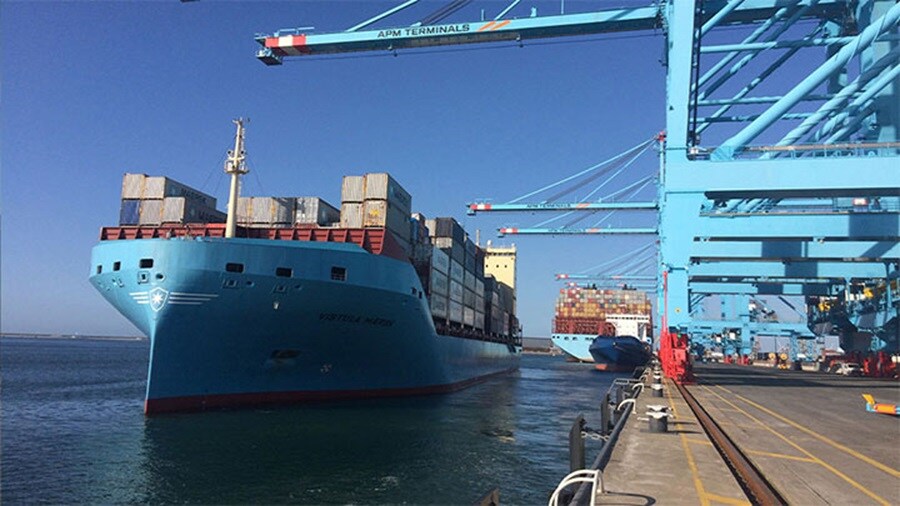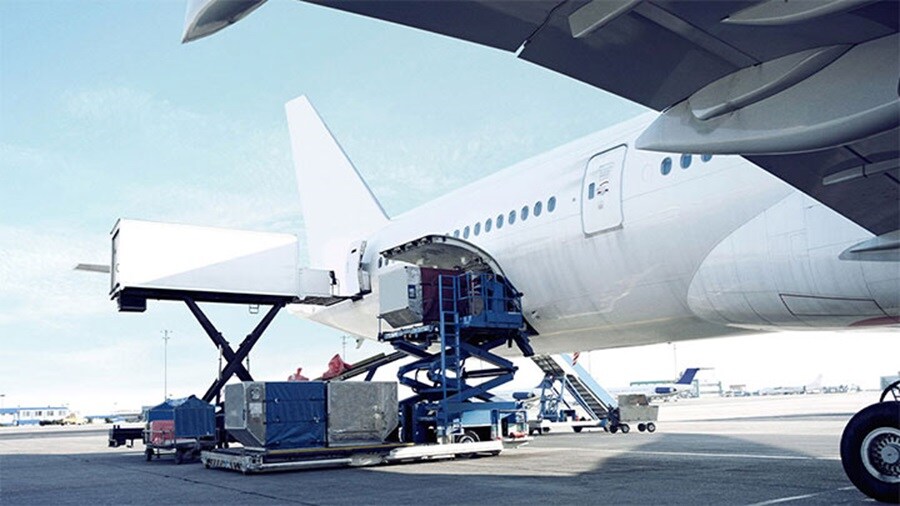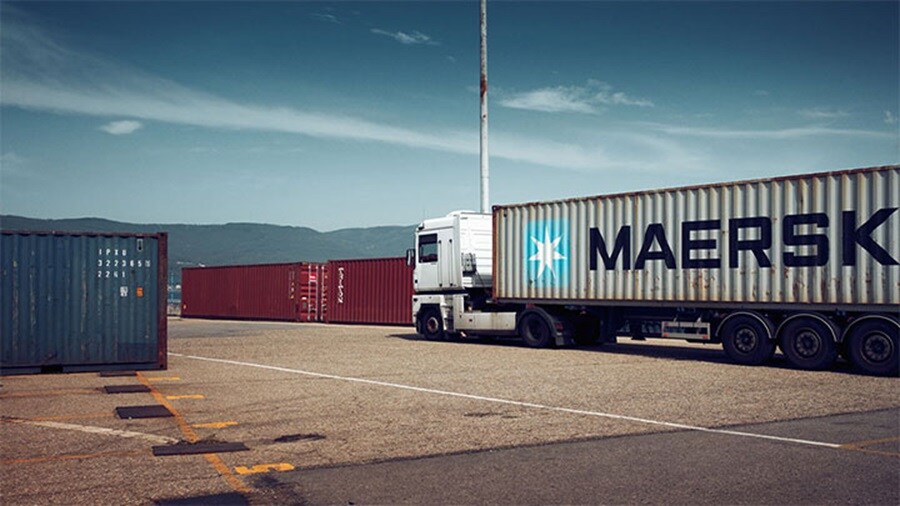Maersk aims to provide you with the latest market update and industry trends every month. Click to subscribe to our e-newsletter.
If you missed the market update for the previous month, you could download it here.
Global trade faces an uncertain outlook as the Russia-Ukraine situation leads to higher energy prices and a likely drop in economic growth in Europe. In China, a surge in Covid-19 cases, especially of the highly transmittable Omicron variant, is putting further pressure on supply chains reducing trucking capacity and adding to port congestion even as container terminals remain open and working.
This month, we share the latest trends and current challenges. We also explain Maersk’s latest solutions to help you keep cargo moving.
Market Trend
The Russia-Ukraine situation has made the macroeconomic outlook highly uncertain. Economic data for the first two months of this year had suggested the global economy was set to accelerate as concerns about the impact from the Omicron variant of Covid-19 faded. Instead, the imposition of sanctions by governments on Russia coupled with surging energy prices are likely to have a very significant negative impact, adding to inflationary pressures. How consumers and businesses react to the heightened uncertainty of higher prices and reduced policy support will be key to the outlook for trade. Potential scenarios depend heavily on how the conflict develops, but if energy prices remain at current levels European growth could fall by up to 3% this year, according to analysts. Brent crude hit a 14-year high of $140 per barrel in early March and although prices subsequently fell slightly. Nonetheless most Analysts believe prices will remain elevated for the rest of this year.
The impact on trade flows is difficult to predict. Russian imports and exports constitute about 2% of global volumes for both ocean and air, with a bigger share of around 5% on the Asia-Europe trade and 8% on the intra-Europe trade. Apart from the direct impact from lost, volumes on the Russia trade, we expect a complex redirection of volumes to other regions, in particular reefer and other perishable goods. Higher energy prices, lower consumer demand and volatile financial markets will impact global trade flows but it’s impossible to forecast by how much.
The container shipping industry remained capacity constrained in the first quarter especially from landside disruptions and port bottlenecks that reduced effective vessel capacity. Despite a gradual slowing in spot markets, freight and charter rates remained high. The SCFI index excluding bunker costs was 78% higher in February than a year earlier. The uncertainty over the easing of capacity constraints and equipment make it challenging to predict when freight rates will begin to normalize.
Trending Topic
Covid-19 in China: Local lockdowns and other quarantine measures in response to coronavirus outbreaks in Shenzhen, Shanghai, Qingdao and other cities are creating transport and supply chain bottlenecks even as ports and terminals remain operational. In Shenzhen, Maersk is skipping calls on several services at Chiwan Container Terminal and Yantian International Container Terminal (YICT) to protect schedule reliability as a result of reduced terminal productivity and congestion. We are trying to minimise all delays. Under Maersk’s vessel contingency plan cargo consigned on the Maersk Eureka on the TP2 211N sailing at Chiwan has been delayed to the Maersk Elba 215N sailing; cargo on the AE15 MSC Ingy 211W call at Chiwan has been delayed to the MSC Mirjam 212W sailing; while cargo for the IA1 Merkur Horizon 211N call at YICT has been transferred to the PH3 Evridiki G 213S sailing.
We foresee vessel waiting time will increase at the Yantian and Chiwan terminals. From March 21, container yard opening at Chiwan, Mawan and Shekou container terminals will only be available within four days of a vessel’s estimated time to berth and only after the terminal confirms the advance reservation made by trucking companies for laden containers gate-in.
All depots and warehouses in Shenzhen have re-opened following a week-long lockdown in the city which was lifted on March 20. But landside transportation faces disruption. We foresee a 20% drop in trucking services between Shenzhen and nearby cities due to stricter Covid-19 controls and the need for drivers to have frequent Nucleic Acid tests leading to longer delivery times and higher transport costs.
Haulage services are available at China’s ports including Shanghai, Qingdao and Xiamen but drivers are subject to frequent health checks and must produce a negative NAT report. In Hong Kong, tougher checks and tests on cross-boundary truckers have led to a cut of at least 70% in trucking capacity, which in turn is having a domino effect on the rest of the supply chain.
Please check with you local Maersk representative for the latest information.
Schedule reliability: Vessel delays and port congestion remains a significant problem in US and North Europe. On the US West Coast, Sea-Intelligence forecasts that vessel queues, which dropped to around 66 ships outside Long Beach/Los Angeles in early March due to reduced arrivals from Asia, will climb again from April as the transpacific transit cycle brings more vessels to the West Coast.
Overall, globally, container shipping schedule reliability remains at a very low level. Maersk was once again the most reliable top-14 carrier in January 2022, with schedule reliability of 46.9%, slightly better than a year earlier, according to the latest Sea-Intelligence report in early March. But overall global schedule reliability among the top carriers was at the lowest ever level since Sea-Intelligence started tracking the statistics in 2011.
Ocean Update
Both the conflict in Ukraine and the Covid situation in China have and will carry risks of impacting the global supply chains further. In Maersk we continue to be committed to delivering for our customers, and we are happy that all Chinese ports continue to operate and that waiting times continue to be minimal. We are further investing in supporting our customers via barge and Sea-Rail services to ease the pressure on trucking in China and are staying very close to the situation to be able to advice our customers as timely as possible on any changes to the situation.

- Asia-Europe voyage changes: Maersk has adjusted the voyage numbers and schedules on 11 sailings on its Asia-Europe 1 (AE1) service during weeks 16-26 as part of changes to its network deployment following the Russia-Ukraine conflict and subsequent sanctions imposed against Russia. These have caused a ripple effect across the global supply chain. We are seeing a high degree of uncertainty and significant delays on the network, while restrictions and stringent checks at transshipment hubs have impacted the readiness of export cargo from Asia.
- Oceania improvement: Maersk’s schedule reliability from Ocean to Asia hit 41% in January compared with a market average of 20% despite ongoing operational disruptions. But we do expect increased disruption in New Zealand due to rising Omicron cases. We continue to see positive, and increasing, demand for our ECO Delivery product as a wider range of customers choose an ocean transport model with lower greenhouse gas emissions.
- Key Market Outlook Across Trade Lanes
| Trade Lane | Trade Statement | Port situation update |
|---|---|---|
|
Trade Lane
Asia to North Europe
|
Trade Statement
Overall demand has gradually recovered post-CNY and the market is currently stable at a strong level.
Post CNY allowed a major voyage reset resulting in more stable services in March and April with fewer delays. We will continue to deploy gap loaders if necessary. |
Port situation update
Destination ports are expected to further suffer from congestion due to Russia-bound cargo being stuck in transit. Booking acceptance has been suspended for all Russia and Belarus cargo. We offer free Change of Delivery for customers with alternative destinations and have Flex Hub solutions available for cargo to remain in trans-shipment.
|
|
Trade Lane
Asia to Mediterranean
|
Trade Statement
Market demand remains positive on both the short and long-term business.
In April we are sliding the AE12 and AE15 services to recover vessel schedules and a gap loader will be used to offset lost capacity. Port congestion is expected to lead to vessel delays and ad-hoc port omissions. |
Port situation update
With Israel facing terminal operating restrictions and Algeria affected by feeder congestion we are not accepting any short-term cargo. Booking acceptance has been suspended for Ukraine, Russia and Syria until further notice.
|
|
Trade Lane
Asia to North America
|
Trade Statement
Demand remained positive in Q1 although we see a shift from USWC to USEC.
Port congestion remains very high in most locations, also trucking and on other inland services. Ocean capacity lost due to missed sailings from port congestion is expected to continue. |
Port situation update
Among US ports Savannah, Newark, Baltimore have a 1-2 day wait time; the wait time at Seattle, Miami, Norfolk is 3 days; Charleston, Houston is 12 days and Los Angeles and Long Beach, 35 days wait time, while Oakland is 11 days. In Vancouver and Prince Rupert continue to experience significant delays.
|
|
Trade Lane
Asia to Latin America
|
Trade Statement
Overall demand seems to be slowing due mainly to the number of extra loaders and inventory overstocking at destination. Short-term rates are easing although long-term rates are stable because volumes are strong. NORs are still a priority, especially to Brazil, Chile, Ecuador and Peru.
|
Port situation update
Cargo movement at San Antonio is delayed due to labor shortages and low productivity.
|
|
Trade Lane
Asia to West Central Asia
|
Trade Statement
The Eid holiday in May is set to create positive demand from the end of March for the Middle East/Red Sea/Pakistan market. India’s imposition of an extra 40% tax on solar panels from March 31 is likely to have a medium-term impact on solar cargoes. The FI4 service to Southeast India was restored to a weekly sailing from February.
|
Port situation update
Colombo port is facing operational delays due to high yard density and bad weather disruption.
|
|
Trade Lane
Asia to Africa
|
Trade Statement
Overall demand in South Africa looks much better both for long term and SPOT bookings.
The West Africa market is still soft, but it is expected to pick up from April with factories fully back to production. Service reliability has improved as port congestion eases. East Africa demand is quite slow after CNY and we expect it to gradually pick up from April. |
Port situation update
Dar Es Salaam is facing long waiting times of 19-21 days resulting in vessels delays and sliding. We will give early notice of space transfer to minimize the impact on customers. Service to Mombasa is running very smoothly. The suspension of Nacala cargoes has been lifted although customers are guided to use other Mozambique ports. The wait time at Cape Town is around 7 days and customers are advised to use Durban.
|
|
Trade Lane
Asia to Oceania
|
Trade Statement
Gradual improvement in overall demand post CNY. Capacity available for cargo from China to East Coast Australia, but we expect very tight capacity China to West Coast Australia. Capacity from South East Asia to East Coast Australia is expected to continue to be very limited. Customers should consider the possibility of transshipment in South China.
|
Port situation update
In Australia, Brisbane port has been closed due to bad weather. Vessel contingencies triggered as vessels have been unable to berth. Climate activists have announced a campaign to disrupt Sydney’s Port Botany in the coming months.
In Auckland, the average waiting time is 11 days and is expected to worsen. Maersk is diverting vessels to other ports. |
|
Trade Lane
Oceania Export
|
Trade Statement
We see high demand from Australia to North East Asia during Q2. A large cotton crop is anticipated from late April that will ensure export volumes to South East Asia remain firm to October. Covid-19 and weather-related delays have had a negative impact on reefer exports from Australia in Q1, although expected to improve Q2.
New Zealand export demand is expected to remain strong in March and April supported by the reefer export peak season. |
Port situation update
Heavy rain and flooding in Queensland has affected Brisbane and Maersk can offer airfreight for time sensitive cargo as an alternative. Customers can use Maersk landside solutions including trucking to Sydney. Staff absence at the Port of Auckland is around 15% due to Covid-19 cases.
|
|
Trade Lane
Asia Import
|
Trade Statement
Tanjung Port hub operations are stable. In China, the Beibu Gulf including Fangcheng, Beihai and Qinzhou reopened for booking acceptance while space still very tight. There is a limit of 50 20' dry or 30 40' dry containers per shipment to avoid split bookings or feeder delays. Taichung is experiencing a feeder overflow until week 16 and we suggest bookings are made to other ports. At Sanshan in South China, imports of frozen meat and frozen aquatic products have been suspended by local customs due to Covid-19.
|
Port situation update
|
Air Update

- Greater China: The closure of Russian airspace to overflights due to the Ukraine situation has reduced capacity to Europe due to the suspension of services by some carriers or significantly longer flying times for others.
Covid-19 flareups in key China cities and a significant reduction in Shenzhen-Hong Kong cross border trucking is shifting more volumes to Guangzhou and alternate airports in central and east China. Airlines are frequently adjusting their schedules to adapt to these impacts and fluctuations in volumes in recent weeks.
Maersk is introducing a new Zhengzhou-Liege weekly return charter service starting in April to help customers adjust to recent capacity reductions to Europe. The service will provide connections to major China and European cities through our seamless transfer service.
- Australia and New Zealand: Maersk has secured block space from Shanghai to Melbourne and Sydney which offer reliable transit and competitive cost benefits. Freight costs have seen a slight improvement from Shanghai to Oceania this month. Singapore continues to provide better cargo options into Oceania than Hanoi because capacity shortages hold rates at higher levels. Freight rates remain high for Trans-Tasman cargo. The air freight market from Indonesia is stable with improvements in capacity and carrier options.
- Vietnam, Cambodia and Myanmar: Lower demand in all three countries has led to a slowdown and several airlines have cancelled flights in response. Fuel surcharges may increase in the coming months due to the Russia-Ukraine conflict and several airlines have started to apply a war risk surcharge to European and US flights.
Inland Services Update

- Australia and New Zealand: Catastrophic flooding in New South Wales and Queensland in the first half of March have impacted interstate supply chains. Third party warehousing is at a premium and container yards and depots are facing similar challenges due to floods. The easing of disruption to the rail network serving Western Australia has reduced pressure on supply chains.
- Japan and Korea: Demand is still high for trucking services from Yokohama to Tokyo off dock container yards. Bookings are suspended for ICR services including AE18/AE19/AE66/AE77 from and to Russia and Belarus.
- Philippines: Yard utilization is at manageable levels. Trucking rates have increased by 6% due to higher oil prices.
- Indonesia: Inland transport demand is expected to peak in April due to Ramadan and a peak season trucking surcharge will be levied, while volumes are expected to fall in May after Ramadan ends. There is expected to be sufficient trucking capacity to cater for inland export, import and domestic overland and inter-island transport during peak season.
- VCM: The Ho Chi Minh City Government will start collecting the port infrastructure fee for container drop off in the Ho Chi Minh port area from April 1 after being delayed from July 2021. The port area includes the Cat Lai terminal and inland container depots. Strong growth in volumes is expected to continue driven by growth in ocean volumes.
Major Port Update
Major ports update (Vessel waiting time indicator)
| Area | Less than 1 day | 1-3 days | More than 3 days |
|---|---|---|---|
|
Area
Asia-Pacific
|
Less than 1 day
Nansha, Xiamen, Dalian, Shanghai, Busan, Singapore, Port Klang, Tanjung Pelepas
|
1-3 days
Qingdao, Ningbo, Hong Kong, Lyttelton, Tauranga
|
More than 3 days
Yantian, Shekou, Auckland, Sydney
|
|
Area
Rest of World
|
Less than 1 day
Santos, Balboa, Buenaventura, Tin Can
|
1-3 days
Bremerhaven, Durban, Newark, Savannah, Baltimore, Tema
|
More than 3 days
Antwerp, Long Beach, Los Angeles, Oakland, Vancouver, Seattle, Prince Rupert, Charleston, Houston, Miami, Norfolk, Apapa, Cotonou, Cape Town, Dar Es Salaam
|
无论您需要什么,我们都可以随时为您提供帮助
I agree to receive logistics related news and marketing updates by email, phone, messaging services (e.g. WhatsApp) and other digital platforms, including but not limited to social media (e.g., LinkedIn) from A. P. Moller-Maersk and its affiliated companies (see latest company overview). I understand that I can opt out of such Maersk communications at any time by clicking the unsubscribe link. To see how we use your personal data, please read our Privacy Notification.
By completing this form, you confirm that you agree to the use of your personal data by Maersk as described in our Privacy Notification.


